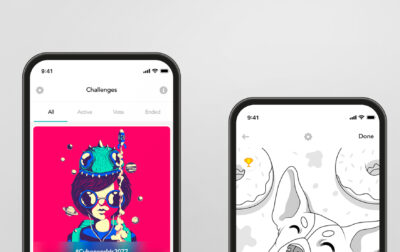Top 6 mistakes to avoid when building a mobile app
Intro
As thousands of apps are released every day and user expectations are at an all-time high, avoiding typical errors is not only wise but also necessary for survival and growth. Even one mistake, like ignoring user experience or market research, can send your app to obscurity. For instance, in 2024 global uninstall rates for mobile Android apps accounted for 41.64 percent 30 days after the first install.
This article explains the six most frequent mistakes that cause mobile app projects to fail – the errors that can cost you money, cause delays, and harm your reputation. Read further if you are creating or intend to create an app. Making a few wise choices now can prevent significant setbacks for your company later on.
1.
Not adapting to market changes
The market for mobile apps is always changing. User expectations are rising, trends are changing quickly, and new competitors are popping up all the time. If an app does not improve after its initial success, it may soon become obsolete. A common error made by businesses is to view app development as a one-time event. They create, let go and continue. However, even well-designed apps run the risk of becoming obsolete if they are not continuously updated.
One example is Clubhouse. In early 2021, it was one of the most talked-about apps, and millions flocked to its invite-only audio chat rooms. But by mid-2022, daily downloads had dropped by over 90%. Why? The app creators disregarded early indicators like a slowdown in the creation of new rooms, user annoyance with audio-only formats, and an increase in the demand for features like text chat and public accessibility.
Meanwhile, competitors like Twitter Spaces and Discord added similar features quickly and opened them to broader audiences, but Clubhouse did not shift its strategy fast enough. Users moved on.
How to stay relevant in a changing market
Build your application with change in mind. Set up a process to gather feedback regularly – this includes app reviews, usage analytics, and direct conversations with users. Watch your competitors closely. If they are introducing features that your users are asking for, act fast.
Additionally, make a roadmap that allows for updates every few weeks, including feature modifications that take into account actual user behavior in addition to bug fixes.
Finally, do not rely only on internal opinions. Keep someone on your team responsible for tracking market shifts – what is trending, what is losing steam, and what new technologies (like AI or voice interfaces) your users might expect next.

2.
Highlighting individual features over practical use
Flaunty features can easily excite one. You might want them in your application because competitors have chatbots, slick user interface animations, or dark modes. However, if the app does not support your business objectives or your users’ everyday struggles – or offer a standout feature that keeps them coming back – all those bells and whistles are useless.
Take into account the experience of Color Labs. This startup rose to fame in 2011 with the eponymous mobile app. The killer feature was proximity-based photo sharing – users could share photos instantly with others nearby, aiming to create spontaneous social connections. However, despite the innovative concept, users soon got frustrated with the app’s interface and purpose – even the founders of Color Labs admitted that they wasted an opportunity with the application. By the end of 2012, Color Labs shut down.
How to stay relevant in a changing market
Start by asking – What problem does our app solve? Not what can it do, but what does it fix for the user or the business? Additionally, go through the following checklist:
- Monitor your competitors and analyze trends. Watch your competitors to spot both their successes and their struggles. This can give you ideas for what to try in your own approach – and what to avoid. At the same time, look at broader market trends to understand where your industry is heading and how customer interests are shifting.
- First, map user flows. Go over how someone will actually use the app before listing features. Where could they become stuck? What is necessary to get them from point A to point B?
- Test early and easily. More can be revealed by a clickable prototype with simple navigation than by a feature-rich pitch deck.
- Make use of meaningful metrics. Do not only monitor downloads. Are users finishing the tasks for which they came? Will they return in a week?
- Speak with customer service. If your company is already established, your support staff is aware of the most common user annoyances. Your app should improve that functionality.
Think about your app like a restaurant – if the kitchen constantly messes up the orders, it does not matter how stylish the décor is.

3.
Ignoring cross-platform compatibility
Imagine that after spending months developing a mobile app, your team finds that half of your customers are unable to use it because they have a different phone than you intended. This situation frequently occurs in the business world and is among the quickest ways to lose market share, money, and momentum.
The business environment of today is diverse in terms of devices. As of Q1 2025, Android accounts for 71.88 percent of mobile device users globally, with iOS having a market share of approximately 27.65 percent during the same period. This means both platforms are essential for reaching a broader audience. If your app works only for one system, you instantly cut off a huge portion of your potential users.
How to stay relevant in a changing market
First and foremost – determine your audience. Are you aiming for users worldwide? A local market? Do not put yourself in an impasse, even if your initial launch is modest.
Utilize cross-platform frameworks, such as Flutter or React Native, to allow your team develop iOS and Android apps from a single codebase. This speeds up updates, cuts down on development time, and maintains a consistent user experience. It is also important to collaborate with QA engineers who test your app on actual devices rather than just simulators. Additionally, decide which operating system versions you will support early on, and develop with those in mind to avoid compatibility issues later.
Applications that meet users where they are are those that expand. You must meet your users on their devices because they will not change them for your app.

4.
Underestimating testing and quality assurance
A lot of companies view testing as the last step before the big launch. What could go wrong with the app? It looks good and works on one or two phones. Actually, quite a bit. App crashes, unclear user interfaces, malfunctioning features, and eventually negative reviews are all results of inadequate testing. What you need to do is verify that the main functions operate consistently across platforms.
According to recent data, user retention is still a significant problem. Several app categories have seen stagnant or even declining retention rates in 2024. For example, Day 1 retention for Android apps dropped 4% from 2023 to 2024.
Users rarely give second chances. If an app fails to deliver from the start, most will never return.
How to stay relevant in a changing market
Test early and test often
Do not wait for the app to be done before testing it. As soon as you have clickable prototypes, you should begin testing. Before a single line of code disrupts production, get usability feedback.
Cover real-world usage
You are not running your app in a lab. It can operate on a five-year-old phone, in a subway with a weak signal, or a person’s hand while they are on the phone. Take it into consideration – do not use emulators, use actual devices.
Invest in QA
The position of quality assurance is not a low one. A competent QA lead will identify problems that would require tens of thousands of dollars to resolve after launch. QAs never think like engineers, they think like your app’s users.
Use crash and performance analytics
In addition to reporting bugs, tools like Sentry and Firebase Crashlytics assist you in identifying trends before users voice their displeasure.

5.
Failing to plan for scalability
Many founders focus only on getting their app to market and rarely think ahead to what comes next. Systems designed for a single purpose frequently break down when user numbers increase or business requirements shift. Slow loading times, frequent crashes, and an upsurge of unfavorable reviews are not just caused by more users – they come from rigid structures that cannot handle change.
Scalability is more than just managing a post-launch surge in downloads. It also refers to the ability to modify, add, or remove features without causing the system as a whole to malfunction. When that flexibility is lacking, teams use shaky fixes to patch things together, which eventually lead to more problems.
How to stay relevant in a changing market
- Build with flexibility in mind. When user numbers spike or your business goals shift, your app will not hit a wall because microservices and cloud-based solutions allow you to adjust easily.
- Invest in database design. Access to data must be reliable and quick. Even as data volumes increase, strategies like caching and sharding keep everything functioning properly.
- Prioritize user experience. Even during periods of high usage, users are kept content and engaged by quick load times and consistent performance.
- Think beyond the tech stack. Make plans for your support systems, such as analytics, performance monitoring, and customer service, to expand along with your application.

6.
Overlooking marketing and user acquisition
No matter how good your app is, no one will use it if you launch it without a clear marketing and user acquisition strategy. The truth is harsh – the lack of a well-thought-out plan to draw in and retain users is the main reason why most apps fail, not bugs or missing features.
Here is a real-life example. HSBC, a major British bank, launched Zing in early 2024 to compete with fintech titans such as Revolut and Wise. But even though 131,000 customers were onboarded, less than 9,000 users were active on the app, falling short of engagement goals. A slow onboarding process and a lack of differentiation from HSBC’s current platforms were identified by analysts as the main problems.
How to stay relevant in a changing market
Since attention is the most valuable resource in today’s app economy, start your marketing early. Here are the tips to alleviate your efforts:
- Tap into your existing audience. Targeted email campaigns and clever site banners can encourage high-intent users to download and install your app. First-purchase discounts or access to exclusive content are examples of incentives that can work in your favor.
- Create a buzz with influencers and creators. Authentic interest can be generated by collaborating with reputable voices in your niche. For instance, Spotify reached millions of people with its 2024 campaign for its new podcast features through influencer partnerships and celebrity hosts.
- Run targeted paid campaigns. Platforms such as Google, TikTok, and Meta provide scalable methods for expanding your user base. These channels are crucial for expanding beyond your current audience, even though the average cost per acquisition is about $29. Use deep links, test creatives, and measure ROI by real user actions rather than just installs.
- Optimize App Store presence. To increase visibility and draw in a variety of user demographics, update app store listings frequently with appropriate keywords, eye-catching images, and region-relevant content.
- Engage with user feedback. To find areas that need improvement, keep an eye on reviews and comments. Promptly resolving user complaints can increase loyalty and satisfaction.

Conclusion
It takes more than just writing code and putting it live to create a mobile application. This is an intricate process that necessitates a well-defined plan, keen insight into user behavior, and flexibility. Months of effort can be undone by a single mistake, whether it is ignoring testing or marketing strategies – or holding onto out-of-date features.
Successful applications are not the most ostentatious or feature-rich ones. They are the ones who remain rooted in user experience, adjust to change, and solve actual problems.
Thus, spend some time making sure everything is in order beforehand. Converse with your users. Test frequently, ship small, and never stop refining. There is a good chance that your app will stand out in a crowded store if it can expand with your users.
And if you need an experienced team to support your app development, we at Touchlane will be happy to help you handle the most intricate technical aspects and avoid mistakes when creating your app. Contact our team to see how we can become an integral part of your state-of-the-art app journey.
RELATED SERVICES
CUSTOM MOBILE APP DEVELOPMENT
If you have an idea for a product along with put-together business requirements, and you want your time-to-market to be as short as possible without cutting any corners on quality, Touchlane can become your all-in-one technology partner, putting together a cross-functional team and carrying a project all the way to its successful launch into the digital reality.
If you have an idea for a product along with put-together business requirements, and you want your time-to-market to be as short as possible without cutting any corners on quality, Touchlane can become your all-in-one technology partner, putting together a cross-functional team and carrying a project all the way to its successful launch into the digital reality.
We Cover
- Design
- Development
- Testing
- Maintenance











